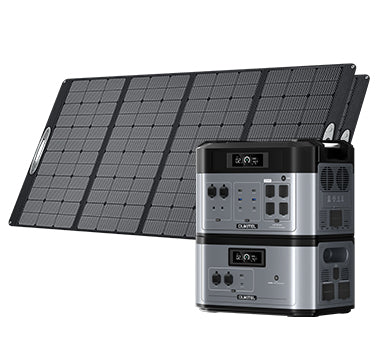Portable Power Stations for Disaster Relief: Providing Power in Times of Crisis
Navigation
Introduction
Portable power stations are revolutionizing how we respond to disasters both large and small. When storms roll in and the power goes out, these resilient batteries offer a beacon of hope by keeping the lights on and critical devices running.

A portable power station uses rechargeable lithium-ion batteries to store electricity. It has built-in AC outlets, DC ports and USB charging slots that allow you to "plug in" various appliances and electronics, providing power even when the grid is down. Once charged, they can run devices for hours or even days, supplying emergency power when it's needed most.
In the chaos after a natural disaster, having a source of backup electricity you can count on is invaluable. Portable power stations allow relief and rescue workers to power medical equipment, phones, tablets and other devices that provide light and communication in dark times. They also offer a lifeline for those sheltering in place by recharging essential items like fans, coolers, refrigerators and assistive technology.
As portable power stations continue to increase in capacity while decreasing in cost, they're transforming how we prepare for - and respond to - both small emergencies and full-scale disasters. This mobile source of electricity represents not just convenience but true hope and resilience in helpless situations.
Benefits for disaster relief
There are plenty of benefits portable power stations provide for disaster relief efforts:
- Power for Medical Devices: Relief workers and first responders can power items like oxygen concentrators, nebulizers, IV pumps, and more with a portable power station. This allows them to provide crucial medical care in areas where the power grid is damaged.
- Lighting: Emergency lighting is vital after a disaster strikes - both for search and rescue missions and for setting up triage centers, shelters, and supply stations. Portable power stations can run LED lanterns, work lamps, string lights and other light sources to illuminate dark areas.
- Communication Devices: Workers need a way to communicate and coordinate relief efforts - and that often requires powering phones, radios, tablets and other devices. Portable power stations recharge these electronics so workers can effectively do their jobs.
- Appliances: Relief organizations use portable power to run small appliances and essential items like fans, mini-fridges, TVs and things that increase comfort levels in shelters and evacuation centers. Anything to make difficult conditions a bit more bearable.
The more capacity a power station has (measured in watt-hours), the more it can effectively support disaster relief work. High-capacity models in the 5,000 watt-hour range can power multiple devices for teams of workers. And units with alternative charging options like solar and car charging become even more valuable in disaster situations.
Portable power truly represents hope and aid when infrastructure and the power grid fail communities that need support the most. The benefits ripple outward, touching countless lives in ways both practical and profound.
Read more: Indoor Generators and Sustainability: Reducing Your Carbon Footprint with Backup Power

Important factors to evaluate
Several factors are important to evaluate when choosing a portable power station for disaster relief work:
- High Capacity: You'll want a power station with a high capacity, measured in watt-hours, to effectively run multiple devices for teams of relief workers. Aim for at least 5,000 watt-hours.
- Multiple Outputs: Look for units with several AC outlets, DC ports and USB slots so you can power various appliances and electronics in parallel. The more versatility, the better.
- Long Runtime: Consider how many consecutive hours you'll likely need power for. Larger capacity power stations with 5000Wh of battery storage can run devices for multiple days.
- Multiple Charging Options: Having alternative ways to recharge the power station makes it far more useful during disasters when the grid is down. Look for units you can charge via solar panels and vehicle outlets.
- Durability: Power stations used for disaster relief need to be rugged and able to withstand extreme conditions.
These factors can help relief organizations chose portable power stations that excel in providing resilience, flexibility and longevity - the key ingredients to make a real difference in people's lives during times of crisis.
There will always be room to improve, but getting the right tools in the hands of those serving on the frontlines is a true gift.
Final thoughts
Imagine having a source of power you could rely on when everything else fails - lights coming on in the darkness, devices saving lives, comfort brought to those in need. That's the gift portable power stations offer during times of crisis and disasters both large and small.
Innovation that truly serves people during their most helpless moments has a beauty all its own. It reminds us of our shared humanity and limitless human capacity for care, sacrifice and generosity of spirit. The resilience these power banks represent is a reflection of the best within us all.
My encouragement to you is to find a portable power station that aligns with your values - whether to donate to a relief organization or keep on-hand for personal emergencies. With the right tool in your hands, you gain the power to make a lifesaving difference for others simply by being prepared.
But whatever solution you land on, let it serve as a reminder that real power comes not from any technology - but from the caring hearts of people who show up, stand up and speak up for those in need. May the spirit of service that inspired the creation of these portable power stations also inspire you forward on your own unique journey of contribution.
The world needs your light. Don't wait for a disaster to switch it on. Shine brightly from within, right here and now. You never know whose darkness you might illuminate along the way.







































 Oukitel Flashlight
Oukitel Flashlight Oukitel Solar
Extension Cable
Oukitel Solar
Extension Cable

















Leave a comment